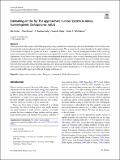Files in this item
Estimating on the fly : the approximate number system in rufous hummingbirds (Selasphorus rufus)
Item metadata
| dc.contributor.author | Corliss, Mia | |
| dc.contributor.author | Brown, Theo | |
| dc.contributor.author | Hurly, T. Andrew | |
| dc.contributor.author | Healy, Susan D. | |
| dc.contributor.author | Tello-Ramos, Maria C. | |
| dc.date.accessioned | 2020-12-16T15:30:20Z | |
| dc.date.available | 2020-12-16T15:30:20Z | |
| dc.date.issued | 2021-03 | |
| dc.identifier | 271522757 | |
| dc.identifier | 7242cc5e-7d83-4179-81f0-a4fb9d8b3316 | |
| dc.identifier | 85085610723 | |
| dc.identifier | 000598715900001 | |
| dc.identifier.citation | Corliss , M , Brown , T , Hurly , T A , Healy , S D & Tello-Ramos , M C 2021 , ' Estimating on the fly : the approximate number system in rufous hummingbirds ( Selasphorus rufus ) ' , Learning and Behavior , vol. 49 , no. 1 , pp. 67–75 . https://doi.org/10.3758/s13420-020-00448-z | en |
| dc.identifier.issn | 1543-4494 | |
| dc.identifier.other | ORCID: /0000-0002-8059-4480/work/85570353 | |
| dc.identifier.uri | https://hdl.handle.net/10023/21160 | |
| dc.description | Funding: Association for the Study of Animal Behaviour. | en |
| dc.description.abstract | When presented with resources that differ in quantity, many animals use a numerosity system to discriminate between them. One taxonomically widespread system is the approximate number system. This is a numerosity system that allows the rapid evaluation of the number of objects in a group and which is regulated by Weber’s Law. Here we investigated whether wild, free-living rufous hummingbirds (Selasphorus rufus) possess an approximate number system. The hummingbirds were presented with two experiments. In the first we investigated whether hummingbirds spontaneously chose an array containing more flowers than an alternate array. In the second we asked whether the hummingbirds could learn to use numerosity as a cue to which of two arrays contained the better reward. The birds did not spontaneously prefer an array containing more flowers. After minimal training, however, they learned to choose the more numerous array and could differentiate between arrays of five and seven flowers. These data support the presence of an approximate number system in the rufous hummingbird. It seems plausible that having such a system would enable much more efficient foraging in this species. | |
| dc.format.extent | 9 | |
| dc.format.extent | 1048504 | |
| dc.language.iso | eng | |
| dc.relation.ispartof | Learning and Behavior | en |
| dc.subject | Approximate number system | en |
| dc.subject | Foraging | en |
| dc.subject | Numerosity | en |
| dc.subject | Rufous hummingbird | en |
| dc.subject | QH301 Biology | en |
| dc.subject | DAS | en |
| dc.subject.lcc | QH301 | en |
| dc.title | Estimating on the fly : the approximate number system in rufous hummingbirds (Selasphorus rufus) | en |
| dc.type | Journal article | en |
| dc.contributor.institution | University of St Andrews. School of Biology | en |
| dc.contributor.institution | University of St Andrews. Centre for Biological Diversity | en |
| dc.contributor.institution | University of St Andrews. Centre for Social Learning & Cognitive Evolution | en |
| dc.contributor.institution | University of St Andrews. Institute of Behavioural and Neural Sciences | en |
| dc.identifier.doi | 10.3758/s13420-020-00448-z | |
| dc.description.status | Peer reviewed | en |
| dc.identifier.url | https://link.springer.com/article/10.3758%2Fs13420-020-00448-z#Sec12 | en |
This item appears in the following Collection(s)
Items in the St Andrews Research Repository are protected by copyright, with all rights reserved, unless otherwise indicated.

